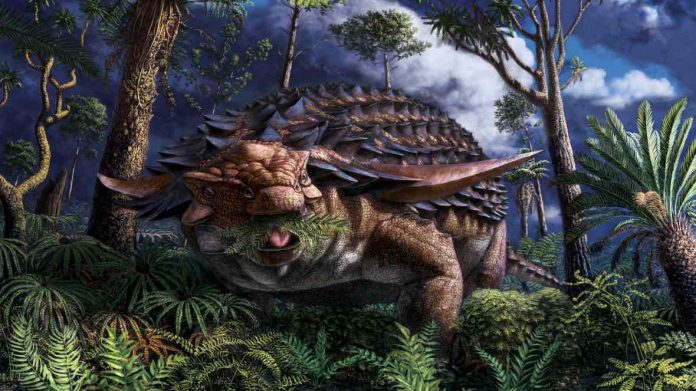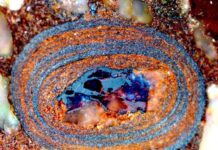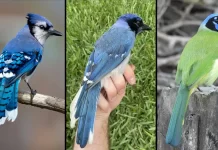Fossil plant matter found in the gut of the exquisitely preserved herbivore reveals its diet and even the season of its death.
In a new study, published June 3, 2020 in the journal Royal Society Open Science, researchers have described the stomach contents preserved in this exceptional specimen. A distinct mass about the size of a soccer ball representing the stomach contents, known as a ‘cololite,’ is located inside the abdominal cavity and is full of exquisitely-preserved plants eaten by the animal. Cololites are not to be confused with coprolite (fossilized feces), but both can indicate dietary preferences. Direct evidence of diet in the form of preserved stomach contents is very rare in the dinosaur fossil record. Less than a dozen cases have been reported for herbivorous dinosaurs, and most of these either are not actually stomach contents, or tell us very little about diet. As a result, which specific plants herbivorous dinosaurs ate is largely a mystery, and is inferred based on tooth and jaw shape, and plant availability and digestibility. This new study changes what we knew about the diet of large herbivorous dinosaurs.
Drs. Caleb Brown, Donald Henderson, and Dennis Braman of the Royal Tyrrell Museum worked with Dr. David Greenwood, Masters student Jessica Kalyniuk, and Cathy Greenwood from Brandon University, and Dr. James Basinger from the University of Saskatchewan to analyze the contents of the cololite. Their research provides the most detailed and conclusive direct evidence of diet in a herbivorous, non-avian dinosaur.
Fourteen criteria supported this detailed study of the fossilized stomach contents. Thin sections of the cololite were analyzed under a microscope. Forty-eight palynomorphs (microscopic organic-walled microfossils like pollen and spores) were discovered. They included moss or liverwort, 26 clubmosses and ferns, 13 gymnosperms (mostly conifers), and just two angiosperms (flowering plants). The cololite also contains some gastroliths, or stomach stones, generally swallowed by animals such as herbivorous dinosaurs, and birds such as geese today, to help with digestion. Some burnt plant fragments were found as well, indicating this nodosaur was feeding in an environment that had recently burned. This aligns with growing evidence that forest fires were very common in the conifer and cycad-dominated forests around the world during the Early Cretaceous. This may also suggest the animal’s feeding ecology is linked to forest regrowth after a wildfire, commonly seen in large herbivores alive today.
The last meal of Borealopelta consisted of 88% leaf material, with a 7% minor stem/twigs component. Ferns dominated the leaf section, and the bits of twigs showed distinct growth rings. In one of the twigs, the outermost ring is incomplete, indicating death occurred in the late spring to mid- summer. Significantly, the ferns consumed by Borealopelta appear to belong to the largest group of ferns alive today, called the leptosporangiate ferns. These are the ferns most people would encounter on a walk in the woods, such as wood ferns (Dryopteris) and even tree ferns like those you might see in Hawaii or Mexico.
It appears that Borealopelta was a picky eater, choosing to not eat some ferns that were common in the Early Cretaceous Alberta landscape. Co-authors Kalyniuk, Basinger, and Greenwood were able to determine what food plants were available by studying the fossil leaves found in the Gates Formation, a rock unit exposed in coal mines in the Rocky Mountain foothills. This rock unit also preserves trackways left by nodosaurs, and is the same age as the sediments that preserved Borealopelta. The extinct fern Cladophlebis (a relative of the royal fern Osmunda) and the horsetail Equisetites were common in the Gates Formation, as were the leaves of cycads, extinct pines, and redwood relatives. However, conifer and cycad leaves are rare in the cololite, and there was no evidence of the royal fern relative or horsetail. Parallels are found today where deer are selective feeders, while moose are less picky about what they eat.
Sometime following its last meal 112 – 110 million years ago, Borealopelta died, and its body washed out to sea in what is now northern Alberta. It sank rapidly on its back, and was perfectly preserved by the fine sediments that covered it. Previous research on this mummified dinosaur has revealed it was reddish-brown in colour, being darker on top, and lighter underneath. Called countershading, this animal evolved its colours as a means of camouflage. Even though heavily armoured, it still needed to defend itself from Early Cretaceous predators.
Research will continue on this extraordinary specimen of Borealopelta to learn more about its environment and behaviour while it was alive.















